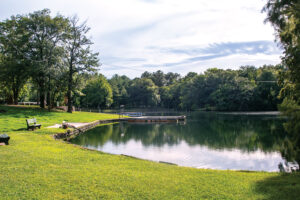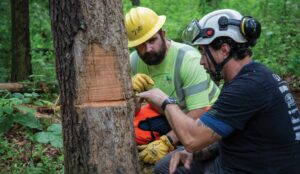“Quite a few people would come into the post office just to see the mural in the lobby,” says Karen Rhodes, who worked as a clerk in the East Alton post office for 32 years. “Many were from out of town, but they had knowledge it was there.”

Titled “The Letter,” the mural by Francis Foy has decorated a wall in the East Alton post office since 1938, soon after the building was dedicated in 1935. It depicts two women at the front gate of a house surrounded by flowers, sharing the content of a letter delivered moments earlier by the postman who remains visible walking down the street.
It is one of 77 post offices murals, mostly in rural Illinois towns, painted between 1934 and 1943. Like Foy’s art, most were in the lobby, centered over the door leading into the postmaster’s office.
“The Illinois murals are part of the over 1,200 murals commissioned by the U. S. Treasury’s Section of Fine Arts near the end of the Depression,” says United States Post Office historian Jenny Lynch. “They were installed in post offices in every state during President Franklin Roosevelt’s administration. The objective was to make people feel uplifted and positive during a difficult time in our history, while also creating something of lasting beauty and significance to American citizens. Importantly, they also provided work for unemployed artists.”
“Almost all remain displayed exactly where they were first installed,” says David W. Gates, Jr. of Crystal Lake, Ill., and he knows what he is talking about. An avid fan of anything post office related, Gates has visited and photographed every one of the Illinois murals, and has an objective of visiting all that exist nationwide.

Gates says post office lobbies were selected to display the art because at the time these were some of the most frequented businesses in each community. The result is a most unique art gallery spanning the nation, with each work of art in the “collection” separated by many miles.
The artists were commissioned based on their previous work, or drawings they submitted, but the competition to be awarded a mural was open to anyone.
The Section of Fine Arts had no preference of style or school of painting. However, judging from the art that now exists, there were preferred themes. Acceptable subjects were local or historical places or events, people of local fame, scenes of daily life or postal history.
Once an artist was selected to paint a mural for a specific post office, they were encouraged to visit or at least write to the postmaster and important local citizens for suggested topics.
The murals have been displayed long enough that many have been restored. Rhodes says the East Alton mural was cleaned about 15 years ago. “After the people who did the work spent two days on a ladder, it looked wonderful,” she says.
Gates says most of the murals were painted at the same time many new post offices were being built. “If the construction of a building came in under budget, 1 percent of the excess was set aside for art,” he says.

While the funds were primarily applied toward a painted mural, the dollars could also be used for other art mediums. For example, in Evanston, sculptor Robert Russin created two cast aluminum sculptures for the interior lobby. These sculptures, “Throwing the Mail” and “Mail Handler,” are each 7 feet tall and are covered with 23 carat gold foil. Outside, two exterior entrance doors are each topped with carved limestone reliefs done by Armin A. Scheler entitled “The Message” and “The Answer.”
In the Decatur post office, different artists painted multiple murals in separate hallways. Edward Millman, who studied under the famous Mexican muralist Diego Rivera, painted three murals in one hall depicting early pioneers. Mitchell Siporin’s three panels in the central hall emphasize hardworking, grim-faced agricultural and industrial workers.
The third hall contains a series of three, two-panel murals by Edgar Britton who studied under Grant Wood. Frank Lloyd Wright and Carl Sandburg are paired in two of the murals and John Deere and Francis Parker in two others. Two additional murals show the development of Illinois through the hardship of early families and industrial workers.
Siporin and Millman also collaborated on nine murals for the St. Louis post office. It totaled nine panels covering 3,000 square feet and was the largest commission of the program, taking two years to complete.
Nationally, some murals have vanished, and that was the case with the Herrin mural “George Rogers Clark Conferring with Indians near Herrin Illinois,” painted by Gustaf Dahlstrom in 1940.
In the 1960s, the Herrin post office was remodeled, and the mural disappeared only to be recovered more than four decades later. Through the efforts of the United States Postal Service, fundraisers and private donations, $28,000 was raised to restore the art. After six months of restoration work, a dedication ceremony took place when it was returned and put on display in 2011.
Throughout Illinois, and nationwide, the murals generally remain sources of local pride, but they are also frequently overlooked. Often the background of the painters has been forgotten, as has the reason why they were commissioned and installed.
To formally recognize the artistic and historical importance of the murals in the history of the nation, in April 2019 the U.S. Postal Service issued a set of stamps that reproduced five of the more than 1,200 murals.
Learn more
To locate the Illinois post office murals spread across the state, visit the interactive map at: https://www.newdealartregistry.org/map/IL/.
To learn about David Gates’ quest to document murals in every state, sign up for his newsletter at: www.davidwgatesjr.net.









